Initiation Rites: On DAG Museum's Apprenticeship Programme
Initiation Rites: On DAG Museum's Apprenticeship Programme
Initiation Rites: On DAG Museum's Apprenticeship Programme
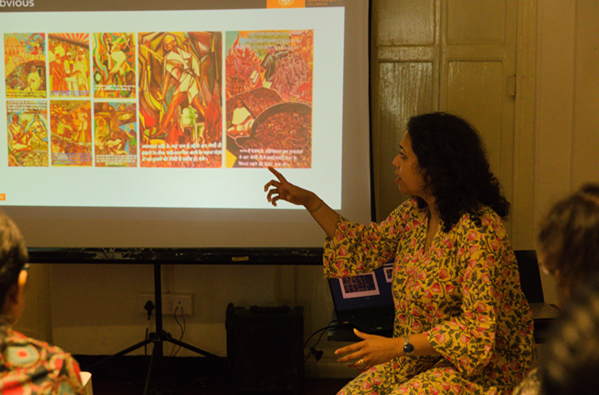
As India’s New Education Policy proposes to integrate apprenticeships into formal curricula, a pressing question emerges: how might these opportunities be structured to promote greater accessibility?
Especially within the museum and arts sector, where the process of selection remains opaque, typically limited to students of art history, museology, or fine arts. Yet the functioning of a museum relies on an array of disciplines that extend beyond the arts. Consider the economics of running a museum: ticketing, maintenance, cost of amenities, which require to be drawn up into a business model. Importing a template from the commercial world is not enough. They must gain a sensitivity to art and culture, a training conspicuously absent in most programmes.
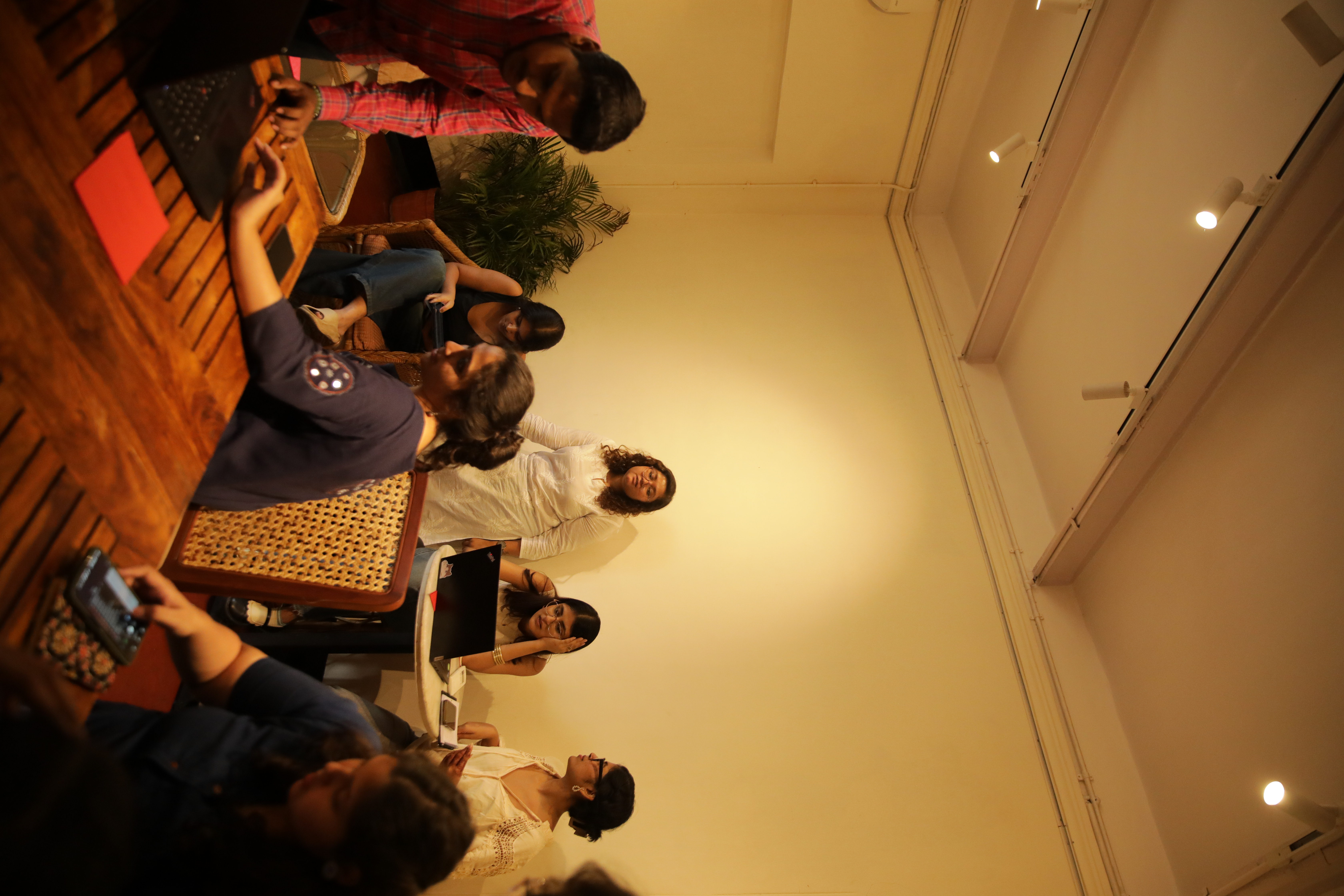
|
Apprentices engaged in a working session with the DAG Team |
The Programme:
When the Museum Apprenticeship Programme was designed as part of the Jamini Roy House Museum project, we had to ensure a training experience that reflected the full complexity of museum work. The roles spanned from translation, collections research, museum merchandise, business model and creating access to secondary research. Crucially, these roles were open to students from all disciplines and the selection process tested the research and creative abilities of the applicants. The applicant pool was refreshingly diverse—commerce graduates applied for translation roles, while design students showed interest in business modelling. This subtle but significant shift challenged long-held assumptions about typical roles within cultural institutions.
We live in an age where disciplinary boundaries are porous, where the art world is expanding to accommodate computer technology, architects, game designers, and digital content creators. The design of this apprenticeship program acknowledged that museums, as cultural institutions, thrive on interdisciplinary knowledge. As we work toward establishing the Jamini Roy House Museum in Kolkata, we see the project being enriched by the contributions of people from different disciplines and expertise. DAG Museums’ summer apprenticeship reflects this ethos: a balance of work and learning. While the apprentices received close guidance by the DAG team, six professionals were invited to conduct mentorship sessions with our ten apprentices.
The Sessions:
For the opening session Dr. Mrinalini Venkateswaran, Deputy Director of Trusts at the Maharaja Sawai Man Singh Museum II in Jaipur introduced apprentices to the process of collections research and exhibition design. Mrinalini began with a simple question: What is the purpose of documentation? To explore the idea, she asked each apprentice to exchange a personal object with another and ask three questions about it. The activity brought forth wallets given as gifts, trinkets carried as tokens of memory, even a grandparent’s wedding photograph—objects that unlocked deeply personal histories. In doing so, she introduced the apprentices to the foundational step in curating a museum: gathering data to uncover narratives. Whether rooted in personal memory or public history, it is data that determines what is included, and how it is interpreted. To put theory in practice, Mrinalini shared her process of curating for ‘March to Freedom’, an exhibition with DAG that required mapping how each artwork fit the historical arc, and for ‘Tea and Tiger’, a digital project connecting Asian nations through shared cultural signifiers. Not all artworks can be accommodated, but Mrinalini advised that, alternate means like activity tables or publications can be employed to feature them. Exhibitions can entail a method of curating objects and artworks, and open a narrative direction through means of writing captions that provoke questions and highlight unknown histories of objects.
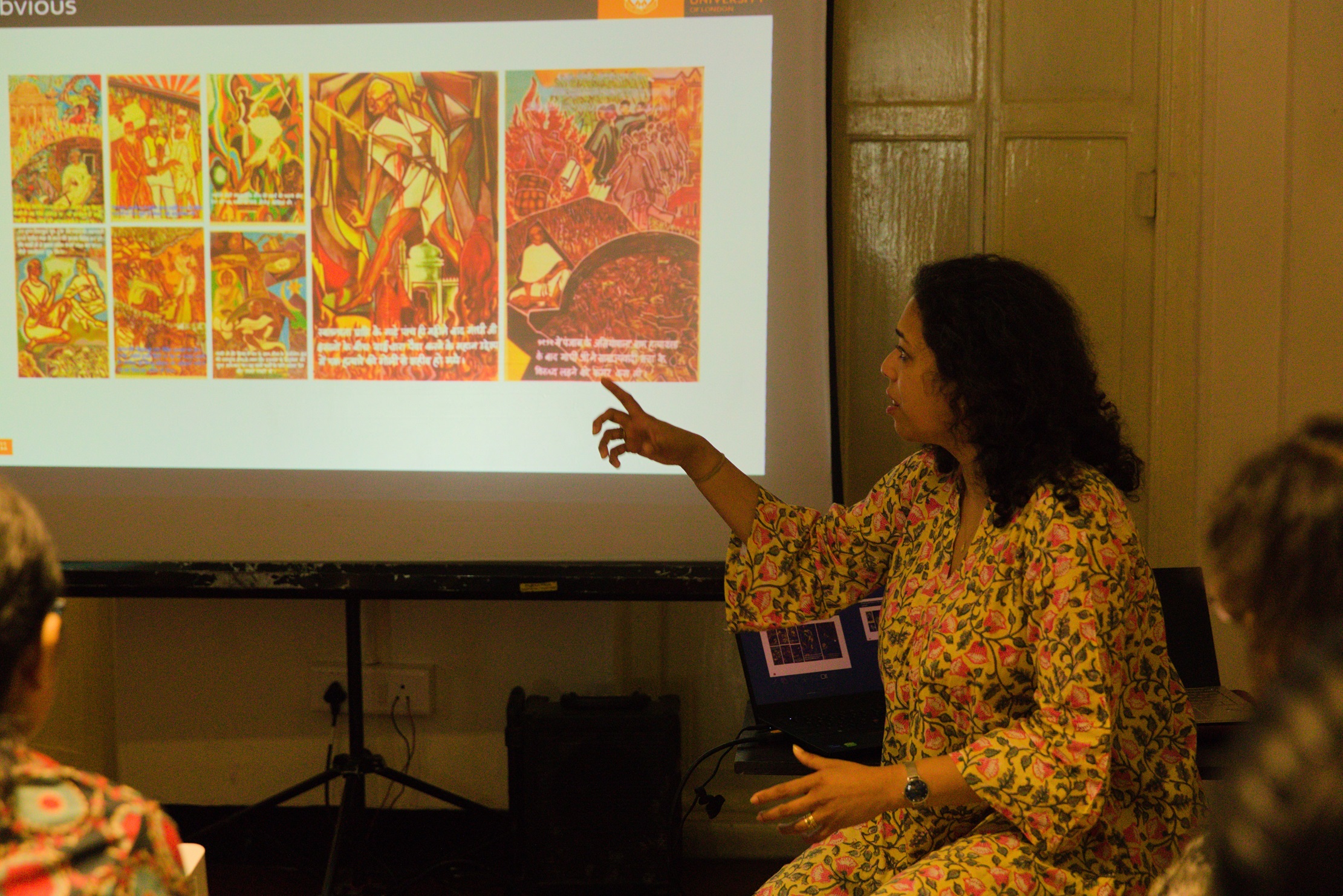
|
Dr. Mrinalini Venkateswaran taking the apprenticesh through March to Freedom, the exhibition she curated for DAG |
Setting up a museum involves a return to archival material like correspondence, personal documents and writing. For the Jamini Roy House Museum, much of the archival material exists in Bangla and translation has typically served as the bridge between diverse cultural contexts. For our next session, to investigate and make these narratives available, Dr. Sayantan Dasgupta, founder of the Centre for Translation of Indian Literature, highlighted the delicate process of rendering one language into another. It is a challenge to translate Indian languages into English as we don’t just translate text from a source language to a target language but a cultural world. In writing, personal idiosyncrasies and cultural registers defy translation. A translator, Dr. Dasgupta advised, must begin with historical, political, and emotional context of the text’s production. The translator must be cognisant of the purpose of translation, which is about accounting if the text will be used as reference or a catalogue essay. The session culminated in a hands-on translation task that sparked discussions over cultural registers and linguistic elasticity. He signed off saying that every translation visibilises the translator’s own politics.
We then arrived at another crucial question: for museums to sustain themselves, revenue from cafes, gift shops, or admission charges tend to be essential. But how does one build a business model that is not exclusively oriented around profit? Rewant Lokesh, who heads business operations at Sienna, emphasised the importance of reinvention and personalisation within a business model. A museum aims at curating an experience for its visitors and that experience must extend to its relationship with collaborators, partners, and the community it inhabits. Drawing from his own experience of building two businesses, Rewant opined that a brand is durable when it has a story rooted in its people and ethics of the brand. Equally important is the need to invite partnerships and brand alliances, that offer meaningful perspectives. For a space like the Jamini Roy House Museum, where every aspect of its design should evoke the story of the artist, the business strategy too should be designed to align with this narrative.
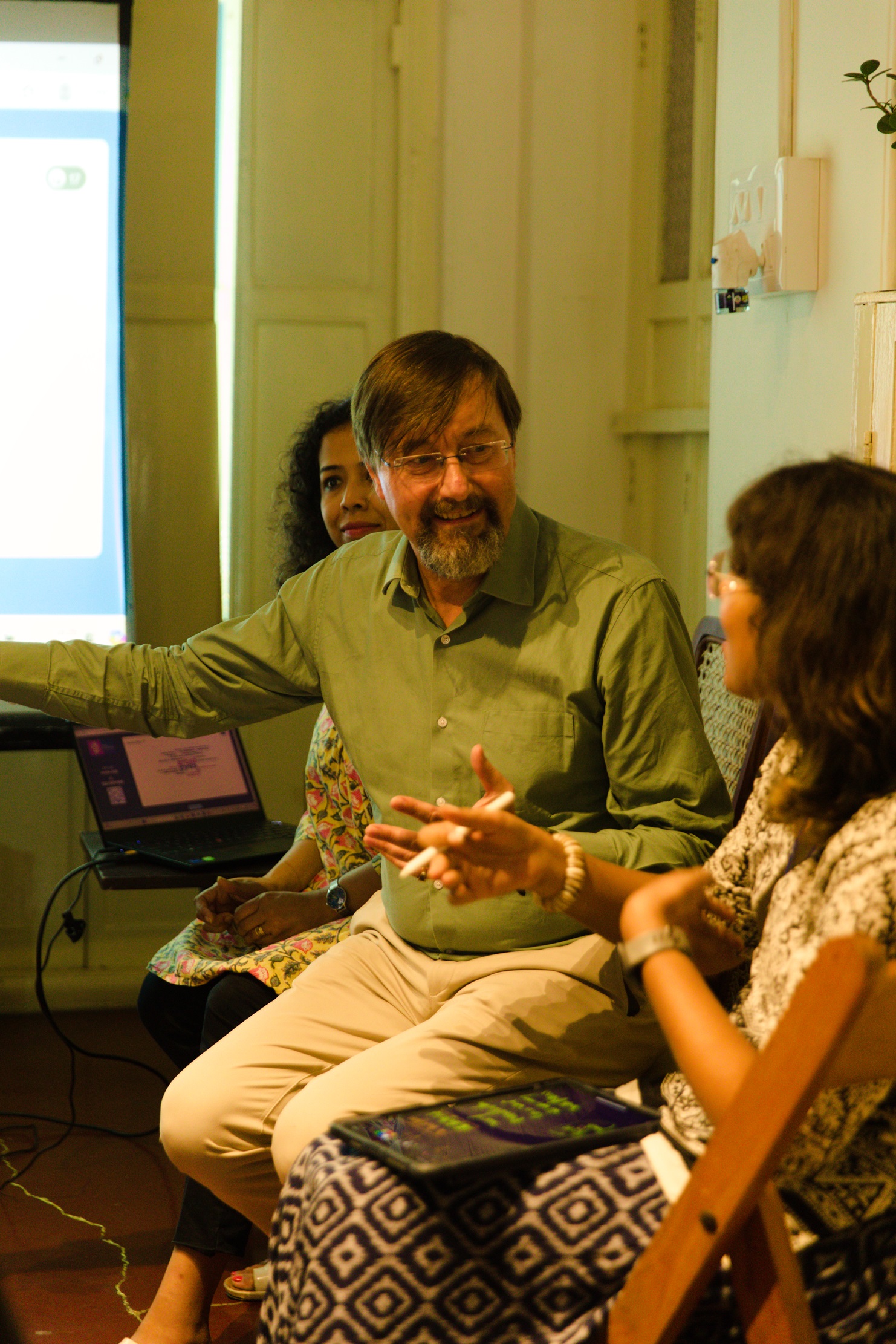
|
Dr. Giles Tillotson, S. V. P. at DAG, talking about his experience with exhibition curation and design |
Given the museum centers on the artist himself, Dr. Sanjukta Sundareson, who has critically looked at the aesthetic of Jamini Roy contextualised his work within a wider art historical discourse. Jamini Roy was an artist who brought the visual language of rural and tribal traditions into the aesthetic landscape of the city. What does it mean, then, to stage the rural within an urban space? As Sanjukta noted, during Roy’s time, the idea of the rural was being politically mobilised, particularly through the influence of Mahatma Gandhi. Transforming the artist’s home into a museum is not merely about displaying artworks—it is about reanimating his practices within the space. For Roy, art was inseparable from life; it infused everything he did. His display methods reflected this integration, often juxtaposing his paintings with the craft traditions that inspired them.
Roy consciously dissolved the myth of the singular, exalted artist by producing multiple variations of the same work. He fused folk forms with a modernist aesthetic, collapsing the boundaries between high art and vernacular expression. Alpana motifs, figures from terracotta temples, and the earthy tones of Bengal's soil shaped the distinctive style at the heart of his practice. Dr. Sunderason reminded the apprentices—who will be conducting research on Roy—that his ubiquity in Bengal today, as a widely reproduced visual staple, is part of the politics of his practice. Roy’s project was not just to create art, but to democratise it—embedding artistic traditions within everyday life and making them accessible to all.
On the third day, designer Swarup Dutta joined the apprentices to explore how traditional craft can be meaningfully integrated into contemporary design. Known for his design principle which bridges the disconnect between urban consumers and artisans, he highlighted how in curating merchandise for the museum store, one should gain a deeper engagement with artisans. To work with craft, a designer must be aware of the context to approach the process as a collaboration and not appropriation. He referenced the Patachitra, a form with a rich history of innovation and re-adaptation, which made a space for itself within an urban milieu. As Swarup took the apprentices through his work in interior design, posters and photography, he illustrated how traditional forms can be extended into new visual vocabularies. A designer’s role is to achieve a harmonious balance between the designer’s own language and that of the artisan.
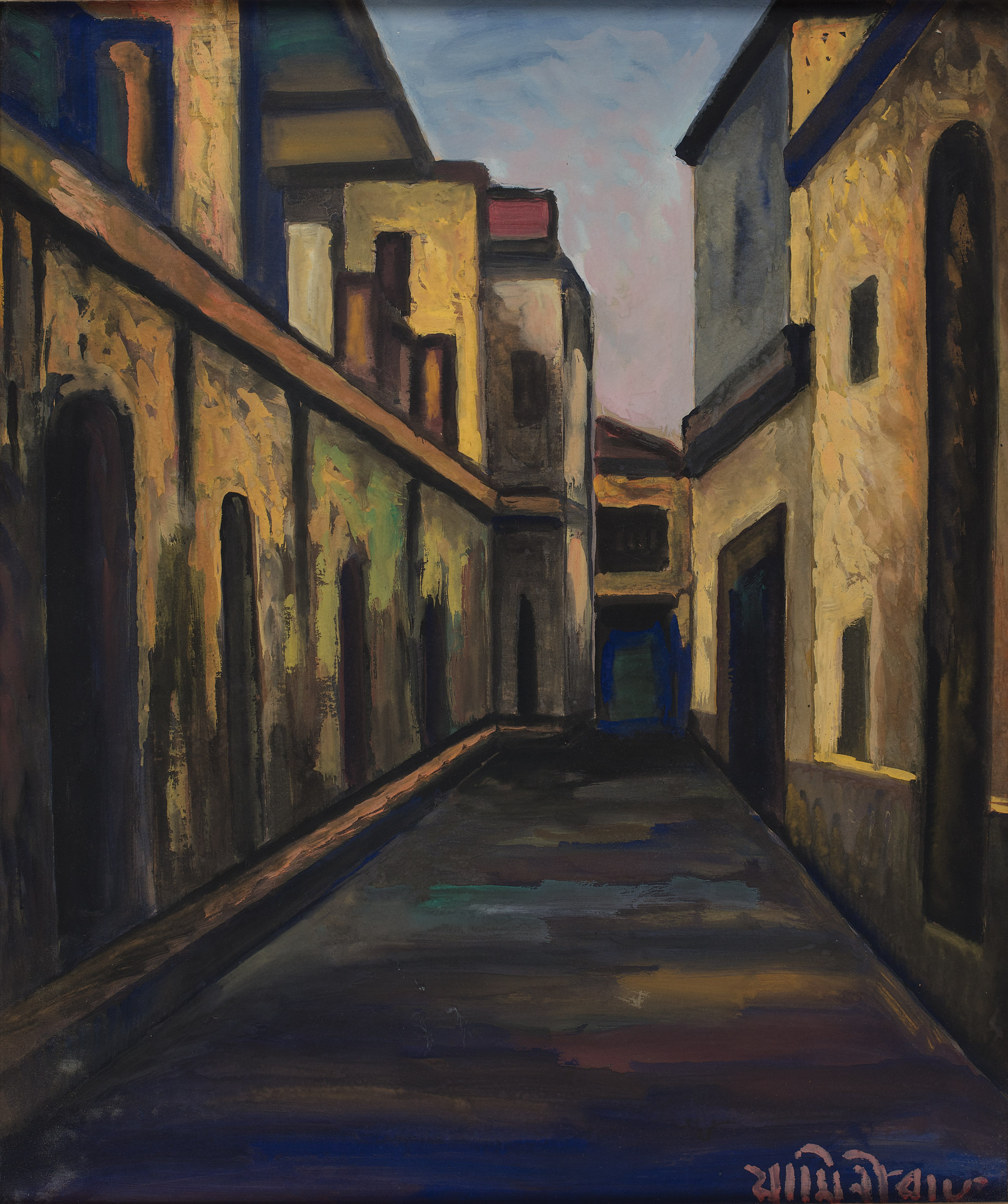
|
Jamini Roy, Untitled. Collection: DAG |
For the final session, Echo Callaghan from the London-based architecture firm Nissen Richards Studio led a conversation on accessibility in museums. Apprentices were encouraged to think critically about what inclusive design truly entails in practice. What makes a museum genuinely accessible? Which technologies help visitors feel more at ease?
Accessibility, Echo emphasised, goes far beyond the addition of ramps or elevators. It involves thoughtful choices—creating sensory-friendly rooms, providing audio guides and tactile signage, designing open floor plans to aid navigation—all of which contribute to a more inclusive experience. Drawing on Nissen Richards Studio’s extensive work in exhibition and museum design, Echo shared examples of how accessibility is embedded into their practice: minimising physical hazards, reducing the need for physical effort, and using symbol-based signage to bridge language barriers. These elements aren’t just functional—they embody a philosophy of universal design that fosters a sense of welcome, ease, and dignity for every visitor.
Looking Behind the Curtain:
The apprentices also participated in sessions with the DAG team, where they were introduced to the methods we use to broaden access to art and deepen public engagement. One exercise asked apprentices to identify unexpected connections between works in the museum’s collection and to imagine public programmes that might emerge from those linkages. These mentorship sessions took place at the Red Bari, a restored heritage home that exemplifies how conservation can be forward-facing. Like the Jamini Roy residence, the Red Bari is steeped in history, yet it resists being cast as a static relic. Instead, it models a living heritage, where the past informs the present. This is the vision guiding the Jamini Roy House Museum: not a shrine to a bygone era, but a living institution that honours the artist’s legacy while remaining viable for the world it now inhabits.
Over the years, our apprentices have brought fresh perspectives and opened new lines of enquiry, bridging disciplines in unexpected and meaningful ways. The mentorship sessions are intentionally designed to expand their critical interests, offering both structure and space for exploration. These sessions remain open to past apprentices, reflecting our commitment to nurturing an ongoing network of emerging scholars and practitioners—a foundation we believe is essential to building a more accessible museum practice.
Ensuring that apprentices are fairly compensated, creating opportunities for them to engage with industry professionals, and enabling meaningful access to the worlds of art and museums are core priorities at DAG Museums. In support of this, we offer two grants through which apprentices can conceptualise and implement their own art engagement programmes in collaboration with DAG.
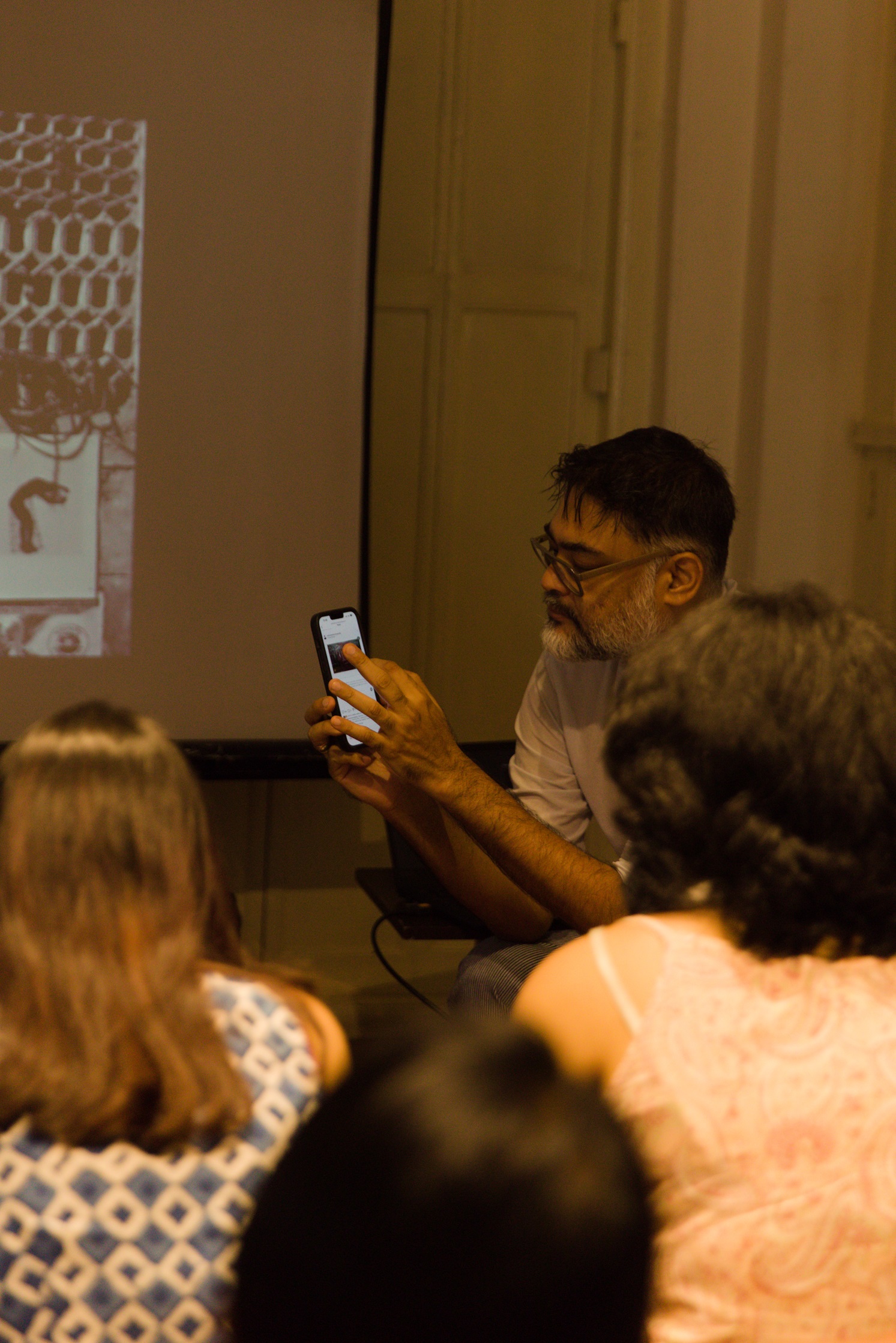
|
Designer Swarup Dutta taking apprentices through his work of co-creating with artisans |


